Dell T3913 User Manual
Dell Precision™ Workstation 470
and Workstation 670
Quick Reference Guide
Models WHM and WHL
w w w . d e l l . c o m | s u p p o r t . d e l l . c o m

Notes, Notices, and Cautions
NOTE: A NOTE indicates important information that helps you make better use of your computer.
 NOTICE: A NOTICE indicates either potential damage to hardware or loss of data and tells you how to avoid the problem.
NOTICE: A NOTICE indicates either potential damage to hardware or loss of data and tells you how to avoid the problem.
 CAUTION: A CAUTION indicates a potential for property damage, personal injury, or death.
CAUTION: A CAUTION indicates a potential for property damage, personal injury, or death.
Abbreviations and Acronyms
For a complete list of abbreviations and acronyms, see the "Glossary" in the User’s Guide.
If you purchased a Dell™ n Series computer, any references in this document to Microsoft® Windows®operating systems are not applicable.
The Quick Reference Guide, Drivers and Utilities CD, and operating system media are optional and may not ship with all computers.
Information in this document is subject to change without notice. © 2004 Dell Inc. All rights reserved.
Reproduction in any manner whatsoever without the written permission of Dell Inc. is strictly forbidden.
Trademarks used in this text: Dell, the DELL logo, and Dell Precision are trademarks of Dell Inc.; Microsoft and Windows are registered trademarks of Microsoft Corporation; Intel and Pentium are registered trademarks of Intel Corporation.
Other trademarks and trade names may be used in this document to refer to either the entities claiming the marks and names or their products. Dell Inc. disclaims any proprietary interest in trademarks and trade names other than its own.
Models WHM and WHL
October 2004 |
P/N T3913 Rev. A01 |
w w w . d e l l . c o m | s u p p o r t . d e l l . c o m

Contents
Finding Information . . . . . . . . . . . . . . . . . . . . . . . . . . . . . . . . |
5 |
Setting Up Your Dell Precision 670 Computer . . . . . . . . . . . . . . . . . . . |
9 |
Setting Up Your Dell Precision 470 Computer . . . . . . . . . . . . . . . . . . |
15 |
Opening the Computer Cover . . . . . . . . . . . . . . . . . . . . . . . . . . |
18 |
Caring for Your Computer . . . . . . . . . . . . . . . . . . . . . . . . . . . . |
22 |
Solving Problems . . . . . . . . . . . . . . . . . . . . . . . . . . . . . . . . |
22 |
Resolving Software and Hardware Incompatibilities . . . . . . . . . . . |
22 |
Microsoft Windows® XP . . . . . . . . . . . . . . . . . . . . . . . . . . |
22 |
Windows 2000. . . . . . . . . . . . . . . . . . . . . . . . . . . . . . . . |
23 |
Using System Restore in Windows XP . . . . . . . . . . . . . . . . . . . |
23 |
Using Last Known Good Configuration . . . . . . . . . . . . . . . . . . . |
24 |
When to Use the Dell Diagnostics . . . . . . . . . . . . . . . . . . . . . |
25 |
Before You Start Testing . . . . . . . . . . . . . . . . . . . . . . . . . . |
25 |
Running the Dell Diagnostics . . . . . . . . . . . . . . . . . . . . . . . . |
26 |
System Lights . . . . . . . . . . . . . . . . . . . . . . . . . . . . . . . . |
27 |
Beep Codes. . . . . . . . . . . . . . . . . . . . . . . . . . . . . . . . . . . . |
28 |
Error Messages . . . . . . . . . . . . . . . . . . . . . . . . . . . . . . . . . |
29 |
Diagnostic Lights. . . . . . . . . . . . . . . . . . . . . . . . . . . . . . . . . |
29 |
Memory Overview . . . . . . . . . . . . . . . . . . . . . . . . . . . . . . . . |
36 |
Frequently Asked Questions . . . . . . . . . . . . . . . . . . . . . . . . . . . |
38 |
Index . . . . . . . . . . . . . . . . . . . . . . . . . . . . . . . . . . . . . . . . . |
41 |
Contents 3

4 Contents
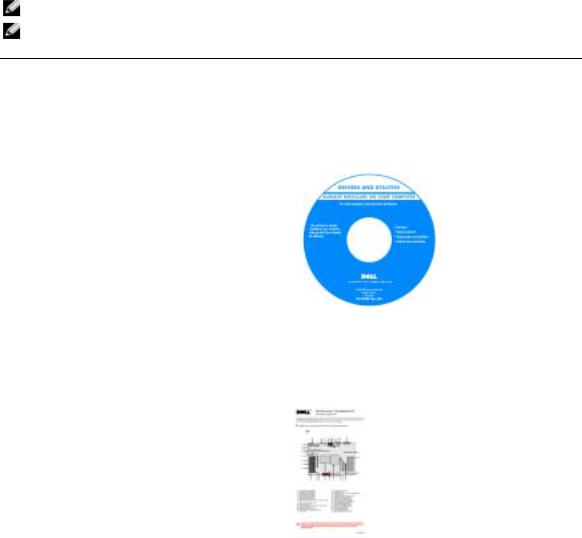
Finding Information
NOTE: Some features may not be available for your computer or in certain countries.
NOTE: Additional information may ship with your computer.
What Are You Looking For? |
Find It Here |
|
|
• A diagnostic program for my computer |
Drivers and Utilities CD (also known as ResourceCD) |
• Drivers for my computer |
Documentation and drivers are already installed on your |
• My computer documentation |
computer. You can use the CD to reinstall drivers, run the |
• My device documentation |
Dell Diagnostics (see page 26), or access your |
• Desktop System Software (DSS) |
documentation. |
|
|
|
Readme files may be |
|
included on your CD to |
|
provide last-minute |
|
updates about technical |
|
changes to your |
|
computer or advanced |
|
technical-reference |
|
material for technicians |
|
or experienced users. |
|
NOTE: Drivers and documentation updates can be found at |
|
support.dell.com. |
|
NOTE: The Drivers and Utilities CD is optional and may not |
|
ship with your computer. |
|
|
• System board connectors |
System Information Label |
• Location of system board components |
|
|
Located on the inside cover of your |
|
computer. |
Quick Reference Guide |
5 |

w w w . d e l l . c o m | s u p p o r t . d e l l . c o m
What Are You Looking For?
•Warranty information
•Terms and Conditions (U.S. only)
•Safety instructions
•Regulatory information
•Ergonomics information
•End User License Agreement
•How to remove and replace parts
•Specifications
•How to configure system settings
•How to troubleshoot and solve problems
•Service Tag and Express Service Code
•Microsoft Windows License Label
Find It Here
Dell™ Product Information Guide
Dell Precision™ Mobile Workstation User’s Guide
Microsoft® Windows® XP Help and Support Center
1 Click the Start button and click Help and Support.
2 Click User’s and system guides and click User’s guides.
The User’s Guide is also available on the optional Drivers and Utilities CD.
Service Tag and Microsoft Windows License
These labels are located on your computer.
•Use the Service Tag to identify your computer when you use support.dell.com or contact technical support.
•Enter the Express Service Code to direct your call when contacting technical support.
6 Quick Reference Guide

What Are You Looking For? |
Find It Here |
|
|
• Solutions — Troubleshooting hints and tips, articles |
Dell Support Website — support.dell.com |
from technicians, online courses, frequently asked |
NOTE: Select your region to view the appropriate support |
questions |
site. |
• Community — Online discussion with other Dell |
NOTE: Corporate, government, and education customers |
customers |
can also use the customized Dell Premier Support website |
• Upgrades — Upgrade information for components, such |
at premier.support.dell.com. The website may not be |
as memory, the hard drive, and the operating system |
available in all regions. |
• Customer Care — Contact information, service call and |
|
order status, warranty, and repair information |
|
• Service and support — Service call status and support |
|
history, service contract, online discussions with |
|
technical support |
|
• Reference — Computer documentation, details on my |
|
computer configuration, product specifications, and |
|
white papers |
|
• Downloads — Certified drivers, patches, and software |
|
updates |
|
• Desktop System Software (DSS) — If you reinstall the |
|
operating system for your computer, you should also |
|
reinstall the DSS utility. DSS provides critical updates |
|
for your operating system and support for Dell™ |
|
3.5-inch USB floppy drives, Intel® Pentium® M |
|
processors, optical drives, and USB devices. DSS is |
|
necessary for correct operation of your Dell computer. |
|
The software automatically detects your computer and |
|
operating system and installs the updates appropriate |
|
for your configuration. |
|
|
|
• How to use Windows XP |
Windows Help and Support Center |
• Documentation for my computer |
1 Click the Start button and click Help and Support. |
• Documentation for devices (such as a modem) |
2 Type a word or phrase that describes your problem and |
|
click the arrow icon. |
|
3 Click the topic that describes your problem. |
|
4 Follow the instructions on the screen. |
Quick Reference Guide |
7 |

w w w . d e l l . c o m | s u p p o r t . d e l l . c o m
What Are You Looking For? |
Find It Here |
|
|
• How to reinstall my operating system |
Operating System CD |
|
The operating system is already installed on your |
|
computer. To reinstall your operating system, use the |
|
Operating System CD. See your Dell Precision User’s |
|
Guide for instructions. |
After you reinstall your operating system, use the
Drivers and Utilities CD to reinstall drivers for the devices that came with your computer.
Your operating system product key label is located on your computer.
NOTE: The color of your CD varies based on the operating system you ordered.
NOTE: The Operating System CD is optional and may not ship with your computer.
•How to use the Red Hat® Linux operating system
•E-mail discussions with other users of Dell Precision™ computers and Linux
•Additional information regarding Linux and my Dell Precision computer
Dell Supported Linux Sites
•http://linux.dell.com
•http://lists.us.dell.com/mailman/listinfo/linuxprecision
•http://docs.us.dell.com/docs/software/oslinux/
8 Quick Reference Guide
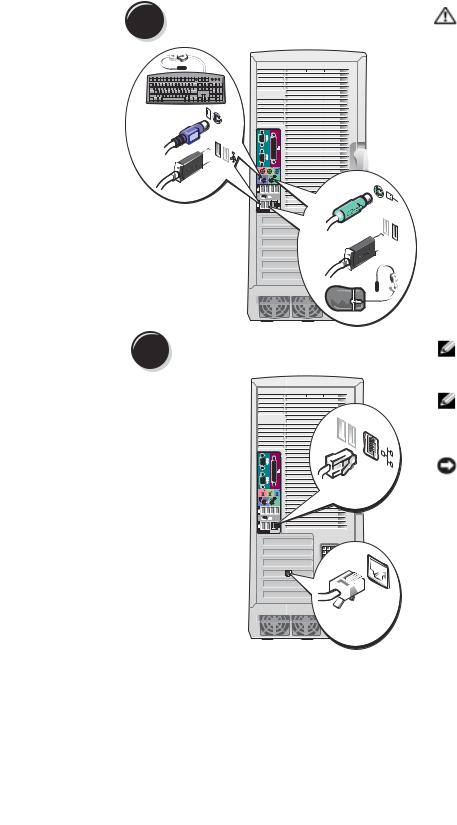
Setting Up Your Dell Precision 670 Computer
1 |
Connect the keyboard and the mouse. |
PS/2 |
or |
|
|
USB |
|
PS/2 |
or |
USB |
CAUTION: Before you begin any of the procedures in this section, follow the safety instructions located in the Product Information Guide.
You must complete all steps to properly set up your computer.
2 |
|
|
|
|
Connect the modem or the network cable. |
||||
|
|
|
|
|
|
|
|
|
|
Network
NOTE: If your computer has a network card installed, connect the network cable to the card.
NOTE: A modem is not included as a standard feature with Dell Precision workstations, but you can order a modem separately.
NOTICE: Do not connect a modem cable to the network adapter. Voltage from telephone communications can damage the network adapter.
Modem
Quick Reference Guide |
9 |
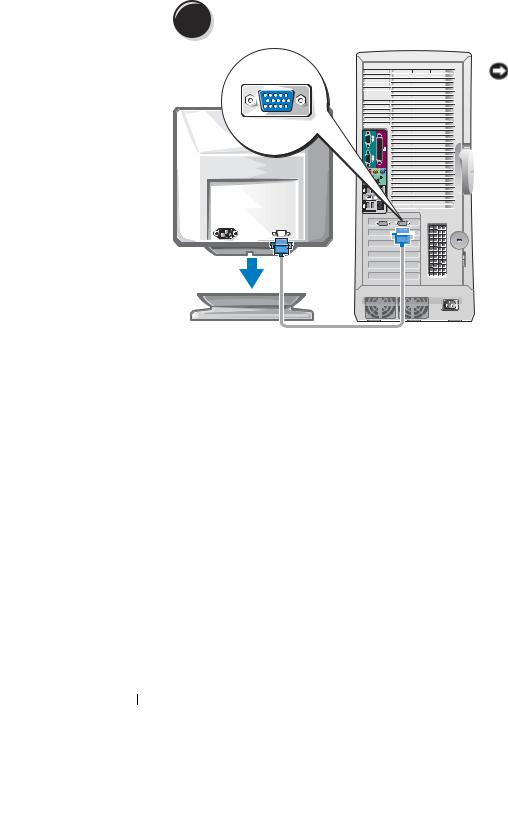
w w w . d e l l . c o m | s u p p o r t . d e l l . c o m
3 Connect the monitor. Depending on your graphics card, you can connect your monitor in
various ways.
NOTICE: You may need to use the provided adapter or cable to connect your monitor to the computer.
10 Quick Reference Guide
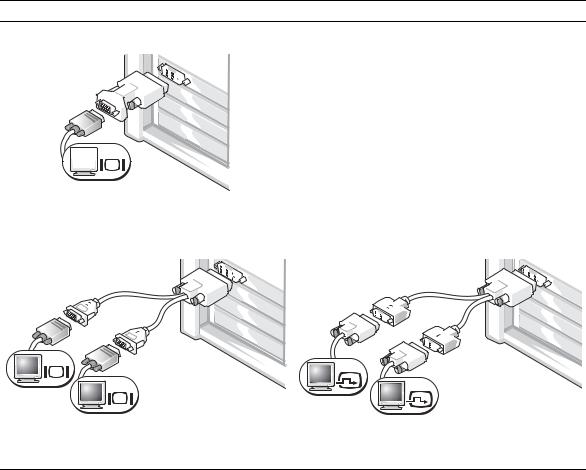
For singleand dual-monitor capable cards with a single connector
VGA Adapter
 VGA
VGA
Use the VGA adapter when you have a single monitor graphics card and you want to connect a VGA monitor.
Dual VGA Y Cable Adapter |
Dual DVI Y Cable Adapter |
VGA |
DVI |
|
|
VGA |
DVI |
Use the appropriate Y cable when your graphics card has a single connector and you want to connect one or two VGA monitors.
Use the appropriate Y cable when your graphics card has a single connector and you want to connect one or two DVI monitors.
The dual-monitor cable is color coded; the blue connector is for the primary monitor, and the black connector is for the secondary monitor. To enable dual-monitor support, both monitors must be attached to the computer when it starts.
Quick Reference Guide |
11 |
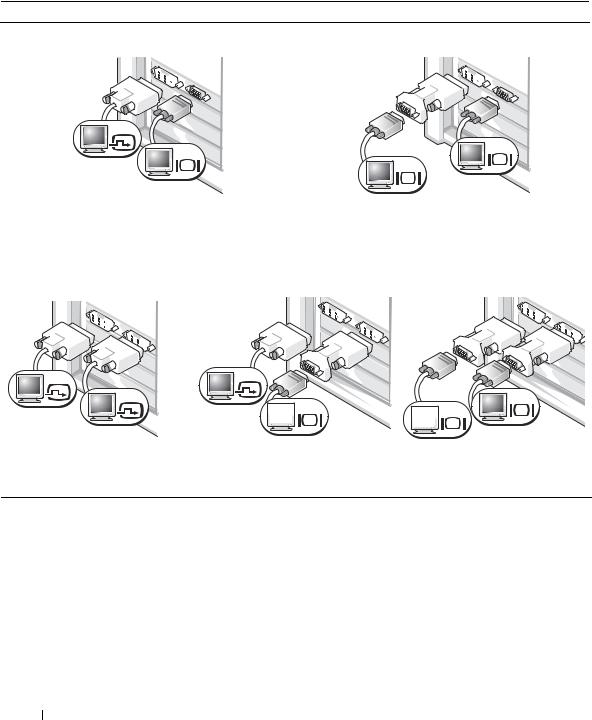
w w w . d e l l . c o m | s u p p o r t . d e l l . c o m
For dual-monitor capable cards with one DVI and one VGA connector
Single DVI/Single VGA |
Dual VGA With VGA Adapter |
DVI
VGA |
VGA |
|
|
|
VGA |
Use the appropriate connector(s) when you connect one |
Use the VGA adapter when you want to connect two VGA |
||
or two monitors. |
|
monitors. |
|
|
|
|
|
For dual-monitor capable cards with two DVI connectors |
|
|
|
|
|
|
|
Dual DVI |
Dual DVI With One VGA Adapter |
Dual DVI With Two VGA Adapters |
|
DVI
DVI
Use the DVI connectors to connect your computer to one or two
DVI monitors.
DVI
 VGA
VGA
Use the VGA adapter to connect a VGA monitor to one of the
DVI connectors on your computer.
 VGA
VGA
 VGA
VGA
Use two VGA adapters to connect two VGA monitors to the DVI connectors on your computer.
12 Quick Reference Guide
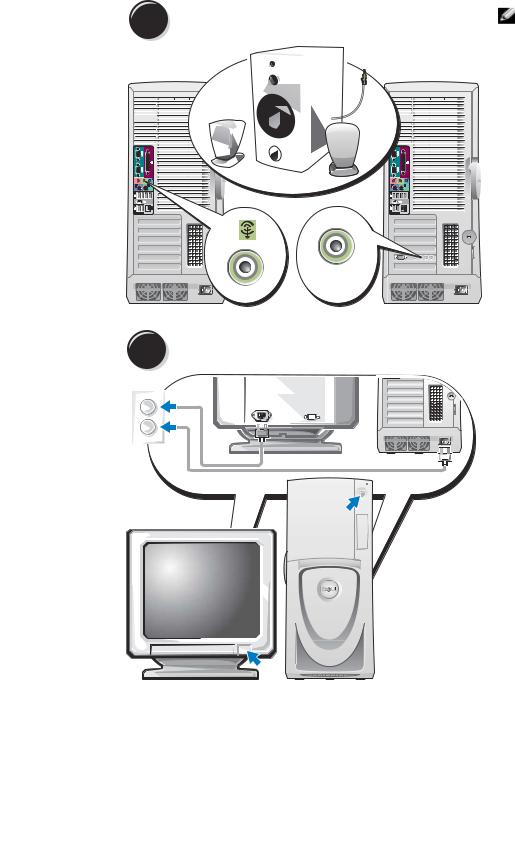
4 |
Connect the speakers. |
NOTE: If your computer |
|
has an audio card |
installed, connect the speakers to the card.
LINE OUT
5 |
Connect the power cables and turn on the computer and monitor. |
|||||||
|
|
|
|
|
|
|
|
|
|
|
|
|
|
|
|
|
|
|
|
|
|
|
|
|
|
|
|
|
|
|
|
|
|
|
|
|
|
|
|
|
|
|
|
|
|
|
|
|
|
|
|
|
|
|
|
|
|
|
|
|
|
|
|
|
|
|
|
|
|
|
|
|
|
|
|
|
|
|
|
|
|
|
|
|
|
|
|
|
|
|
|
|
|
|
|
|
|
|
|
|
|
|
|
|
|
|
|
Quick Reference Guide |
13 |

w w w . d e l l . c o m | s u p p o r t . d e l l . c o m
6 |
Install additional software or devices. |
Before you install any devices or software that did not come with your computer, read the documentation that came with the software or device or contact the vendor to verify that the software or device is compatible with your computer and operating system.
Congratulations! You have completed the setup for your Dell Precision 670 computer.
To access the User’s Guide from your hard drive:
Click the Start button and click Help and Support.
To access your User’s Guide from the Dell Support website:
1Go to support.dell.com.
2Follow the prompts on the website that ask you for information specific to your computer.
3At the Dell Support website home page, click the User Guides link under Product Support, click Systems, and then select your Dell Precision computer.
14 Quick Reference Guide
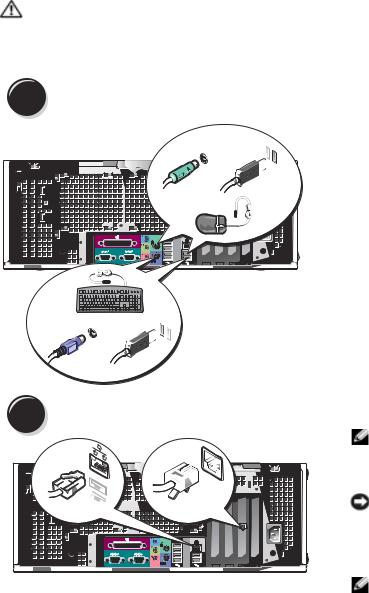
Setting Up Your Dell Precision 470 Computer
CAUTION: Before you begin any of the procedures in this section, follow the safety instructions located in the Product Information Guide.
You must complete all steps to properly set up your computer.
1 Connect the keyboard and the mouse.
PS/2 or USB
PS/2 USB
or
2 |
|
|
Connect the modem or the network cable. |
||||||||||||
|
|
|
|
|
|
|
|
|
|
|
|
|
|
|
|
|
|
|
|
|
|
|
|
|
|
|
|
|
|
|
|
|
|
|
|
|
|
|
|
|
|
|
|
|
|
|
|
|
|
|
|
|
|
|
|
|
|
|
|
|
|
|
|


 network
network







 modem
modem
NOTE: If your computer has a network card installed, connect the network cable to the card.
NOTICE: Do not connect a modem cable to the network adapter. Voltage from telephone communications can damage the network adapter.
NOTE: A modem is not included as a standard feature with Dell Precision workstations, but you can order a modem separately.
Quick Reference Guide |
15 |
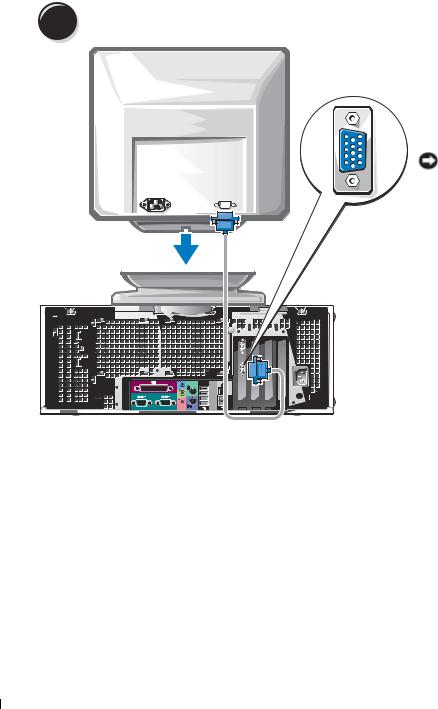
w w w . d e l l . c o m | s u p p o r t . d e l l . c o m
3 Connect the monitor. Depending on your graphics card, you can connect your monitor in various ways.
For information on the different options, see page 11 and page 12.
NOTICE: You may need to use the provided adapter or cable to connect your monitor to the computer.
16 Quick Reference Guide
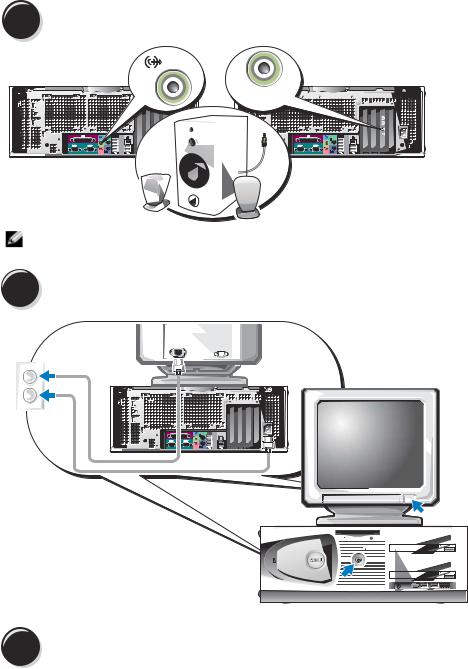
4 |
Connect the speakers. |
|
|
|
|
|
|
|
|
|
|
LINE  OUT
OUT













NOTE: If your computer has an audio card installed, connect the speakers to the card.
5 |
|
Connect the power cables and turn on the computer and monitor. |
|
|
|
|
|
|
|
|
|||||||||||||||||||
|
|
|
|
|
|
|
|
|
|
|
|
|
|
|
|
|
|
|
|
|
|
|
|
|
|
|
|
|
|
|
|
|
|
|
|
|
|
|
|
|
|
|
|
|
|
|
|
|
|
|
|
|
|
|
|
|
|
|
|
|
|
|
|
|
|
|
|
|
|
|
|
|
|
|
|
|
|
|
|
|
|
|
|
|
|
|
|
|
|
|
|
|
|
|
|
|
|
|
|
|
|
|
|
|
|
|
|
|
|
|
|
|
|
|
|
|
|
|
|
|
|
|
|
|
|
|
|
|
|
|
|
|
|
|
|
|
|
|
|
|
|
|
|
|
|
|
|
|
|
|
|
|
|
|
|
|
|
|
|
|
|
|
|
|
|
|
|
|
|
|
|
|
|
|
|
|
|
|
|
|
|
|
|
|
|
|
|
|
|
|
|
|
|
|
|
|
|
|
|
|
|
|
|
|
|
|
|
|
|
|
|
|
|
|
|
|
|
|
|
|
|
|
|
|
|
|
|
|
|
|
|
|
|
|
|
|
|
|
|
|
|
|
|
|
|
|
|
|
|
|
|
|
|
|
|
|
|
|
|
|
|
|
|
|
|
|
|
|
|
|
|
|
|
|
|
|
|
|
|
|
|
|
|
|
|
|
|
|
|
|
|
|
|
|
|
|
|
|
|
|
|
|
|
|
|
|
|
|
|
|
|
|
|
|
|
|
|
|
|
|
|
|
|
|
|
|
|
|
|
|
|
|
|
|
|
|
|
|
|
|
|
|
|
|
|
|
|
|
|
|
|
|
|
|
|
|
|
|
|
|
|
|
|
|
|
|
|
|
|
|
|
|
|
|
|
|
|
|
|
|
|
|
|
|
|
|
|
|
|
|
|
|
|
|
|
|
|
|
|
|
|
|
|
|
|
|
|
|
|
|
|
|
|
|
|
|
|
|
|
|
|
|
|
|
|
|
|
|
|
|
|
|
|
|
|
|
|
|
|
|
|
|
|
|
|
|
|
|
|
|
|
|
|
|
|
|
|
|
|
|
|
|
|
|
|
|
|
|
|
|
|
|
|
|
|
|
|
|
|
|
|
|
|
|
|
|
|
|
|
|
|
|
|
|
|
|
|
|
|
|
|
|
|
|
|
|
|
|
|
|
|
|
|
|
|
|
|
|
|
|
|
|
|
|
|
|
|
|
|
|
|
|
|
|
|
|
|
|
|
|
|
|
|
|
|
|
|
|
|
|
|
|
|
|
|
|
|
|
|
|
|
|
|
|
|
|
|
|
|
6 |
Install additional software or devices. |
Quick Reference Guide |
17 |

w w w . d e l l . c o m | s u p p o r t . d e l l . c o m
Before you install any devices or software that did not come with your computer, read the documentation that came with the software or device or contact the vendor to verify that the software or device is compatible with your computer and operating system.
Congratulations! You have completed the setup for your Dell Precision 470 computer.
To access the User’s Guide from your hard drive:
Click the Start button and click Help and Support.
To access your User’s Guide from the Dell Support website:
1Go to support.dell.com.
2Follow the prompts on the website that ask you for information specific to your computer.
3At the Dell Support website home page, click the User Guides link under Product Support, click Systems, and then select your Dell Precision computer.
Opening the Computer Cover
CAUTION: Before you begin any of the procedures in this section, follow the safety instructions in the Product Information Guide.
1Shut down the computer through the Start menu.
2Ensure that your computer and attached devices are turned off. If your computer and attached devices did not automatically turn off when you shut down your computer, turn them off now.
NOTICE: To disconnect a network cable, first unplug the cable from your computer and then unplug it from the network wall jack.
3Disconnect any telephone or telecommunication lines from the computer.
4Disconnect your computer and all attached devices from electrical outlets, and then press the power button to ground the system board.
5If you have installed a padlock through the padlock ring on the back panel, remove the padlock.
CAUTION: To guard against electrical shock, always unplug your computer from the electrical outlet before opening the cover.
6 Lay the computer on its side as shown in the following illustrations.
NOTICE: Ensure that sufficient space exists to support the open cover—at least 30 cm (1 ft) of desk top space.
18 Quick Reference Guide
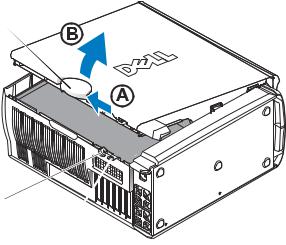
7Open the computer cover:
a Slide the cover release latch toward the top of the computer. b Raise the cover, and pivot it toward the front of the computer.
8Ground yourself by touching an unpainted metal surface on the computer, such as the metal at the back of computer, before touching anything inside your computer.
While you work, periodically touch any unpainted metal surface on the computer to dissipate any static electricity that could harm internal components.
D e l l P r e c i s i o n 6 7 0 C o m p u t e r
cover release latch
security cable slot
padlock ring
Quick Reference Guide |
19 |
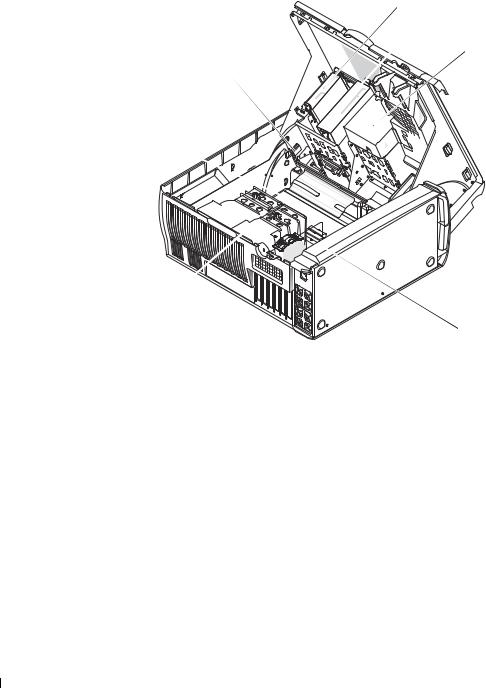
w w w . d e l l . c o m | s u p p o r t . d e l l . c o m
I n s i d e t h e D e l l P r e c i s i o n 6 7 0 C o m p u t e r
floppy drive (optional)
 CD/DVD drive(s)
CD/DVD drive(s)
 hard drive(s)
hard drive(s)
chassis intrusion switch
system board 
processor airflow shroud 
 power supply
power supply
20 Quick Reference Guide
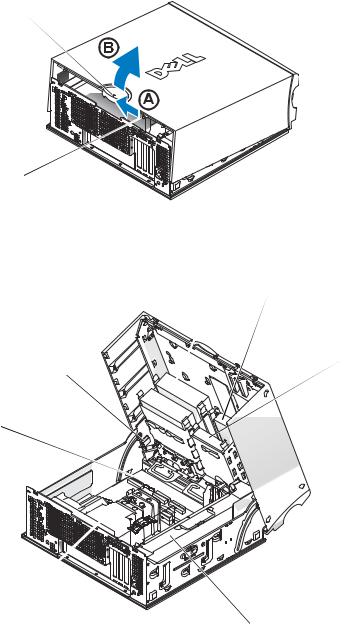
D e l l P r e c i s i o n 4 7 0 C o m p u t e r cover release latch
security cable slot
padlock ring
I n s i d e t h e D e l l P r e c i s i o n 4 7 0 C o m p u t e r
 CD/DVD drive(s)
CD/DVD drive(s)
 floppy drive (optional)
floppy drive (optional)
 hard drive(s)
hard drive(s)
chassis intrusion switch
system board
processor
airflow shroud 
 power supply
power supply
Quick Reference Guide |
21 |

w w w . d e l l . c o m | s u p p o r t . d e l l . c o m
Caring for Your Computer
To help maintain your computer, follow these suggestions:
•To avoid losing or corrupting data, never turn off your computer when the hard drive light is on.
•Schedule regular virus scans using anti-virus software.
•Manage hard drive space by periodically deleting unnecessary files and defragmenting the drive.
•Back up files on a regular basis.
•Periodically clean your monitor screen, mouse, and keyboard (see your User’s Guide for more information).
Solving Problems
Follow these tips when troubleshooting your computer:
•If you added or removed a computer part before the problem started, review the installation procedures and ensure that the part is correctly installed.
•If a peripheral device does not work, ensure that the device is properly connected.
•If an error message appears on the screen, write down the exact message. This message may help technical support diagnose and fix the problem(s).
•If an error message occurs in a program, consult the program’s documentation.
•If the recommended action in the troubleshooting section is to see a section in your User’s Guide, go to support.dell.com (on another computer if necessary) to access your User’s Guide.
Resolving Software and Hardware Incompatibilities
If a device is either not detected during the operating system setup or is detected but incorrectly configured, you can use the Hardware Troubleshooter to resolve the incompatibility.
Microsoft Windows® XP
To resolve incompatibilities using the Hardware Troubleshooter:
1Click the Start button and click Help and Support.
2Type hardware troubleshooter in the Search field and click the arrow to start the search.
3Click Hardware Troubleshooter in the Search Results list.
4In the Hardware Troubleshooter list, click I need to resolve a hardware conflict on my computer, and click Next.
22 Quick Reference Guide

To resolve incompatibilities using the Hardware Troubleshooter:
1Click the Start button and click Help.
2Click Troubleshooting and Maintenance on the Contents tab, click Windows XP troubleshooters, and then click Hardware.
3In the Hardware Troubleshooter list, click I need to resolve a hardware conflict on my computer and click Next.
Windows 2000
To resolve incompatibilities using Device Manager:
1Click the Start button, point to Settings, and then click Control Panel.
2In the Control Panel window, double-click System.
3Click the Hardware tab.
4Click Device Manager.
5Click View and click Resources by connection.
6Double-click Interrupt request (IRQ).
Incorrectly configured devices are indicated by a yellow exclamation point (!) or a red X if the device has been disabled.
7Double-click any device marked with an exclamation point to display the Properties window.
The Device status area in the Properties window reports the cards or devices that need to be reconfigured.
8Reconfigure the devices or remove the devices from the Device Manager. See the documentation that came with the device for information on configuring the device.
To resolve incompatibilities using the Hardware Troubleshooter:
1Click the Start button and click Help.
2Click Troubleshooting and Maintenance on the Contents tab, click Windows 2000 troubleshooters, and then click Hardware.
3In the Hardware Troubleshooter list, click I need to resolve a hardware conflict on my computer and click Next.
Using System Restore in Windows XP
The Microsoft® Windows® XP operating system provides System Restore to allow you to return your computer to an earlier operating state (without affecting data files) if changes to the hardware, software, or other system settings have left the computer in an undesirable
operating state.
NOTICE: Make regular backups of your data files. System Restore does not monitor your data files or recover them.
Quick Reference Guide |
23 |

w w w . d e l l . c o m | s u p p o r t . d e l l . c o m
Creating a Restore Point
1Click the Start button and click Help and Support.
2Click System Restore.
3Follow the instructions on the screen.
Restoring the Computer to an Earlier Operating State
NOTICE: Before you restore the computer to an earlier operating state, save and close all open files and close all open programs. Do not alter, open, or delete any files or programs until the system restoration is complete.
1Click the Start button, point to All Programs→ Accessories→ System Tools, and then click System Restore.
2Ensure that Restore my computer to an earlier time is selected, and click Next.
3Click a calendar date to which you want to restore your computer.
The Select a Restore Point screen provides a calendar that allows you to see and select restore points. All calendar dates with available restore points appear in bold.
4Select a restore point and click Next.
If a calendar date has only one restore point, then that restore point is automatically selected. If two or more restore points are available, click the restore point that you prefer.
5Click Next.
The Restoration Complete screen appears after System Restore finishes collecting data, and then the computer automatically restarts.
6After the computer restarts, click OK.
To change the restore point, you can either repeat the steps using a different restore point, or you can undo the restoration.
Using Last Known Good Configuration
1Restart your computer and press <F8> when the message Please select the operating system to start appears.
2Highlight Last Known Good Setting, press <Enter>, press <l>, and then select your operating system when prompted.
24 Quick Reference Guide

Other Options to Help Resolve Additional Device or Software Conflicts
NOTICE: The following processes erase all of the information on your hard drive.
•Reinstall your operating system using the operating system CD.
NOTE: The operating system CD is optional and may not ship with every computer.
During the operating system reinstallation, you can select to delete the existing partitions and reformat your hard drive.
•Reinstall all drivers, beginning with the chipset, using the optional Drivers and Utilities CD.
When to Use the Dell Diagnostics
If you experience a problem with your computer, run the Dell Diagnostics before you contact Dell for technical assistance. The test results provide important information for Dell's service and support personnel.
NOTICE: Only use the Dell Diagnostics to test your Dell™ computer. Using this program with other computers can cause incorrect computer responses or result in error messages.
The Dell Diagnostics allow you to:
•Perform quick checks or extensive tests on one or all devices.
•Choose how many times a test is run.
•Display or print test results or save them in a file.
•Suspend testing if an error is detected or terminate testing if a certain number of errors occur.
•Access online Help screens that describe the tests and how to run them.
•Read status messages that tell you whether tests completed successfully.
•Receive error messages if problems are detected.
Before You Start Testing
CAUTION: Before you begin any of the procedures in this section, follow the safety instructions in the Product Information Guide.
•Turn on your printer if one is attached.
•Enter system setup, review your computer’s configuration information, and then enable all of your computer’s components and devices, such as connectors.
Quick Reference Guide |
25 |

w w w . d e l l . c o m | s u p p o r t . d e l l . c o m
Running the Dell Diagnostics
It is recommended that you print these procedures before you begin.
1Open the Dell Diagnostics on your hard drive or from the Drivers and Utilities CD.
From your hard drive:
aShut down and restart the computer.
bWhen F2 = Setup appears in the upper-right corner of the screen, press <Ctrl><Alt><F10>.
If you wait too long and the Microsoft® Windows® logo appears, continue to wait until you see the Windows desktop. Then shut down your computer and try again. After the system boots to the Dell Diagnostics, go to step 2.
From the Drivers and Utilities CD:
aShut down and restart the computer.
bWhen F2 = Setup appears in the upper-right corner of the screen, press <F12>.
If you wait too long and the Microsoft Windows logo appears, continue to wait until you see the Windows desktop. Then shut down your computer and try again.
NOTE: This feature changes the boot sequence for one time only. On the next start-up, the computer boots according to the devices specified in system setup.
The Boot Device Menu appears.
cInsert the Drivers and Utilities CD.
dChange the Boot Sequence to use the IDE CD-ROM device as the first device in the boot sequence.
The Dell Diagnostics Menu appears.
eSelect Dell 32-bit Diagnostics from the numbered list. If multiple versions are listed, select the version appropriate for your computer.
2 When the Dell Diagnostics main menu appears, select the type of test you want to perform.
26 Quick Reference Guide

System Lights
These lights on the front of the computer can indicate a computer problem.
Power Light |
Hard-Drive Light |
Cause |
Corrective Action |
|
|
|
|
Solid green |
N/A |
Power is on, and the computer is |
No corrective action is required. |
|
|
operating normally. |
|
Blinking green |
Blank |
The computer is in the suspended |
|
|
state (Windows XP). |
Press the power button, move the mouse, or press a key on the keyboard to wake the computer. See "Power Management" in the User’s Guide for more information.
Blinks green |
N/A |
A configuration error exists. |
Check the diagnostic lights to see if |
several times and |
|
|
the specific problem is identified. See |
then turns off |
|
|
the User’s Guide for more information. |
|
|
|
|
Solid yellow |
N/A |
The Dell Diagnostics is running a |
If the Dell Diagnostics is running, |
|
|
test, or a device on the system |
allow the testing to complete. |
|
|
board may be faulty or |
Check the diagnostic lights to see if |
|
|
incorrectly installed. |
|
|
|
the specific problem is identified. |
|
|
|
|
|
|
|
|
If the computer does not boot, contact |
|
|
|
Dell for technical assistance. |
|
|
|
|
Blinking yellow |
Blank |
A power supply or system board |
Check the diagnostic lights to see if |
|
|
failure has occurred. |
the specific problem is identified. See |
|
|
|
"Power Problems" in the User’s Guide. |
|
|
|
|
Blinking yellow |
Solid green |
A system board or VRM failure |
Check the diagnostic lights to see if |
|
|
has occurred. |
the specific problem is identified. |
|
|
|
|
Solid green and a |
N/A |
A problem was detected while the |
See "Beep Codes" on page 28 for |
beep code |
|
BIOS was executing. |
instructions on diagnosing the beep |
during POST |
|
|
code. Also, check the diagnostic lights |
|
|
|
to see if the specific problem |
|
|
|
is identified. |
|
|
|
|
Solid green power |
N/A |
The monitor or the graphics card |
Check the diagnostic lights to see if |
light and no beep |
|
may be faulty or incorrectly |
the specific problem is identified. Also, |
code and no video |
|
installed. |
see "Video Problems" in the |
during POST |
|
|
User’s Guide. |
|
|
|
|
Solid green power |
N/A |
An integrated system board device |
Check the diagnostic lights to see if |
light and no beep |
|
may be faulty. |
the specific problem is identified. If |
code but the |
|
|
the problem is not identified, contact |
computer locks |
|
|
Dell for technical assistance. |
up during POST |
|
|
|
|
|
|
|
Quick Reference Guide |
27 |

w w w . d e l l . c o m | s u p p o r t . d e l l . c o m
Beep Codes
Your computer might emit a series of beeps during start-up if the monitor cannot display errors or problems. This series of beeps, called a beep code, identifies a problem. One possible beep code (code 1-3-1) consists of one beep, a burst of three beeps, and then one beep. This beep code tells you that the computer encountered a memory problem.
If your computer beeps during start-up:
1Write down the beep code on the Diagnostic Checklist (see your User’s Guide).
2Run the Dell Diagnostics to identify a more serious cause.
3Contact Dell for technical assistance.
Code |
Cause |
Code |
Cause |
|
|
|
|
1-1-2 |
Microprocessor register failure |
3-3-4 |
Video Memory Test failure |
|
|
|
|
1-1-3 |
NVRAM read/write failure |
3-4-1 |
Screen initialization failure |
|
|
|
|
1-1-4 |
ROM BIOS checksum failure |
3-4-2 |
Screen retrace failure |
|
|
|
|
1-2-1 |
Programmable interval timer failure |
3-4-3 |
Search for video ROM failure |
|
|
|
|
1-2-2 |
DMA initialization failure |
4-2-1 |
No timer tick |
|
|
|
|
1-2-3 |
DMA page register read/write failure |
4-2-2 |
Shutdown failure |
|
|
|
|
1-3 |
Video Memory Test failure |
4-2-3 |
Gate A20 failure |
|
|
|
|
1-3-1 |
Memory not being properly identified |
4-2-4 |
Unexpected interrupt in protected |
through |
or used |
|
mode |
2-4-4 |
|
|
|
|
|
|
|
3-1-1 |
Slave DMA register failure |
4-3-1 |
Memory failure above address |
|
|
|
0FFFFh |
|
|
|
|
3-1-2 |
Master DMA register failure |
4-3-3 |
Timer-chip counter 2 failure |
|
|
|
|
3-1-3 |
Master interrupt mask register failure |
4-3-4 |
Time-of-day clock stopped |
|
|
|
|
3-1-4 |
Slave interrupt mask register failure |
4-4-1 |
Serial or parallel port test failure |
|
|
|
|
3-2-2 |
Interrupt vector loading failure |
4-4-2 |
Failure to decompress code to |
|
|
|
shadowed memory |
|
|
|
|
3-2-4 |
Keyboard Controller Test failure |
4-4-3 |
Math-coprocessor test failure |
|
|
|
|
3-3-1 |
NVRAM power loss |
4-4-4 |
Cache test failure |
|
|
|
|
3-3-2 |
Invalid NVRAM configuration |
4-3-4 |
Time-of-day clock stopped |
|
|
|
|
28 Quick Reference Guide
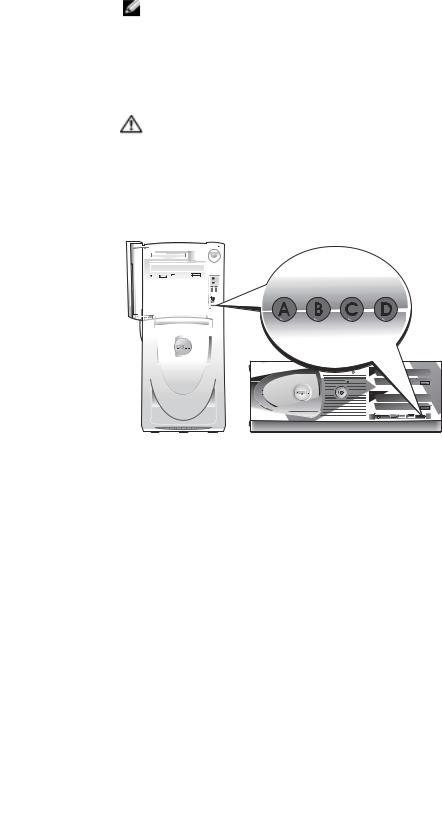
Error Messages
NOTE: If the message is not listed, see the documentation for either the operating system or the program that was running when the message appeared.
If an error occurs during start-up, a message may be displayed on the monitor identifying the problem. See "Error Messages" in your User’s Guide for suggestions on resolving any problems.
Diagnostic Lights
CAUTION: Before you begin any of the procedures in this section, follow the safety instructions located in the Product Information Guide.
To help you troubleshoot a problem, your computer has four lights labeled "A," "B," "C," and "D" on the front panel. The lights can be yellow, green, or off. When the computer starts normally, the lights flash. After the computer starts, all four lights display solid green. If the computer malfunctions, the color and sequence of the lights identify the problem.
|
|
|
|
|
|
|
|
|
|
|
|
|
|
|
|
|
|
|
|
|
|
|
|
|
|
Quick Reference Guide |
|
29 |
|
|
|
|
|
|
|
|
|
|
|
|
|
|
|
|
|
|
|
|
|
|
|
|
|
|
|
||
|
|
|
|
|
|
|
|
|
|
|
|
|
|
|
|
|
|
|
|
|
|
|
|
|
|
|
||
|
|
|
|
|
|
|
|
|
|
|
|
|
|
|
|
|
|
|
|
|
|
|
|
|
|
|
||
|
|
|
|
|
|
|
|
|
|
|
|
|
|
|
|
|
|
|
|
|
|
|
|
|
|
|
||
|
|
|
|
|
|
|
|
|
|
|
|
|
|
|
|
|
|
|
|
|
|
|
|
|
|
|
||
|
|
|
|
|
|
|
|
|
|
|
|
|
|
|
|
|
|
|
|
|
|
|
|
|
|
|
||
|
|
|
|
|
|
|
|
|
|
|
|
|
|
|
|
|
|
|
|
|
|
|
|
|
|
|
||
|
|
|
|
|
|
|
|
|
|
|
|
|
|
|
|
|
|
|
|
|
|
|
|
|
|
|
||
|
|
|
|
|
|
|
|
|
|
|
|
|
|
|
|
|
|
|
|
|
|
|
|
|
|
|
||
|
|
|
|
|
|
|
|
|
|
|
|
|
|
|
|
|
|
|
|
|
|
|
|
|
|
|
||
|
|
|
|
|
|
|
|
|
|
|
|
|
|
|
|
|
|
|
|
|
|
|
|
|
|
|
||
|
|
|
|
|
|
|
|
|
|
|
|
|
|
|
|
|
|
|
|
|
|
|
|
|
|
|
||
|
|
|
|
|
|
|
|
|
|
|
|
|
|
|
|
|
|
|
|
|
|
|
|
|
|
|
||
|
|
|
|
|
|
|
|
|
|
|
|
|
|
|
|
|
|
|
|
|
|
|
|
|
|
|
||
|
|
|
|
|
|
|
|
|
|
|
|
|
|
|
|
|
|
|
|
|
|
|
|
|
|
|
||
|
|
|
|
|
|
|
|
|
|
|
|
|
|
|
|
|
|
|
|
|
|
|
|
|
|
|
||
|
|
|
|
|
|
|
|
|
|
|
|
|
|
|
|
|
|
|
|
|
|
|
|
|
|
|
||
|
|
|
|
|
|
|
|
|
|
|
|
|
|
|
|
|
|
|
|
|
|
|
|
|
|
|
||
|
|
|
|
|
|
|
|
|
|
|
|
|
|
|
|
|
|
|
|
|
|
|
|
|
|
|
||
|
|
|
|
|
|
|
|
|
|
|
|
|
|
|
|
|
|
|
|
|
|
|
|
|
|
|
||
|
|
|
|
|
|
|
|
|
|
|
|
|
|
|
|
|
|
|
|
|
|
|
|
|
|
|
||
|
|
|
|
|
|
|
|
|
|
|
|
|
|
|
|
|
|
|
|
|
|
|
|
|
|
|
||
|
|
|
|
|
|
|
|
|
|
|
|

w w w . d e l l . c o m | s u p p o r t . d e l l . c o m
Diagnostic Light Codes Before POST
Light Pattern |
|
|
Problem Description |
Suggested Resolution |
|||
|
|
|
|
|
|
|
|
|
|
|
|
off |
No electrical power is |
Connect the computer to an electrical outlet. Ensure |
|
|
|
|
|
off |
supplied to the computer. |
that the front-panel power light is on. If the power light |
|
|
|
|
|
|
is off, ensure that the computer is connected to a |
||
|
|
|
|
off |
|
||
A |
B |
C |
D |
|
working electrical outlet and then press the |
||
|
|
|
|
off |
|
power button. |
|
|
|
|
|
|
|
If the problem is still not resolved, contact Dell for |
|
|
|
|
|
|
|
technical assistance. |
|
|
|
|
|
|
|
|
|
|
|
|
|
yellow |
The computer is in a normal |
Press the power button to turn the computer on. |
|
|
|
|
|
off |
off condition; the computer |
If the computer does not turn on, ensure that the front- |
|
|
|
|
|
is connected to an |
|||
A |
B |
C |
D |
off |
panel power light is on. If the power light is off, ensure |
||
electrical outlet. |
|||||||
that the computer is connected to a working electrical |
|||||||
|
|
|
|
off |
|
||
|
|
|
|
|
outlet and then press the power button. |
||
|
|
|
|
|
|
||
|
|
|
|
|
|
If the problem is still not resolved, contact Dell for |
|
|
|
|
|
|
|
technical assistance. |
|
|
|
|
|
|
|
|
|
|
|
|
|
yellow |
The computer is in a reduced |
Use one of the appropriate methods to "wake up" the |
|
|
|
|
|
yellow |
power or "sleep" state. |
computer. See "Advanced Features" in the User’s Guide. |
|
|
|
|
|
|
|
||
A |
B |
C |
D |
off |
|
If the problem is not resolved and you are trying to wake |
|
|
the computer with a USB mouse or keyboard, substitute |
||||||
|
|
|
|
off |
|
||
|
|
|
|
|
the mouse or keyboard with a working PS/2 mouse or |
||
|
|
|
|
|
|
||
|
|
|
|
|
|
keyboard and then try to wake the computer. |
|
|
|
|
|
|
|
|
|
|
|
|
|
yellow |
The BIOS is not executing. |
Ensure that the processor is seated correctly and restart |
|
|
|
|
|
yellow |
|
the computer. |
|
|
|
|
|
|
|
||
A |
B |
C |
D |
yellow |
|
If the problem is still not resolved, contact Dell for |
|
|
technical assistance. |
||||||
|
|
|
|
off |
|
||
|
|
|
|
|
|
||
|
|
|
|
|
|
|
|
|
|
|
|
off |
A possible power supply or |
Perform the procedure in "Power Problems" in the |
|
|
|
|
|
yellow |
power cable failure |
User’s Guide. |
|
|
|
|
|
has occurred. |
|
||
A |
B |
C |
D |
off |
If the problem is still not resolved, contact Dell for |
||
|
|||||||
|
technical assistance. |
||||||
|
|
|
|
off |
|
||
|
|
|
|
|
|
||
|
|
|
|
|
|
|
|
|
|
|
|
off |
A possible system board |
Contact Dell for technical assistance. |
|
|
|
|
|
off |
failure has occurred. |
|
|
|
|
|
|
|
|
||
A |
B |
C |
D |
yellow |
|
|
|
|
|
|
|
off |
|
|
|
|
|
|
|
|
|
|
|
= yellow = green = off
30 Quick Reference Guide
